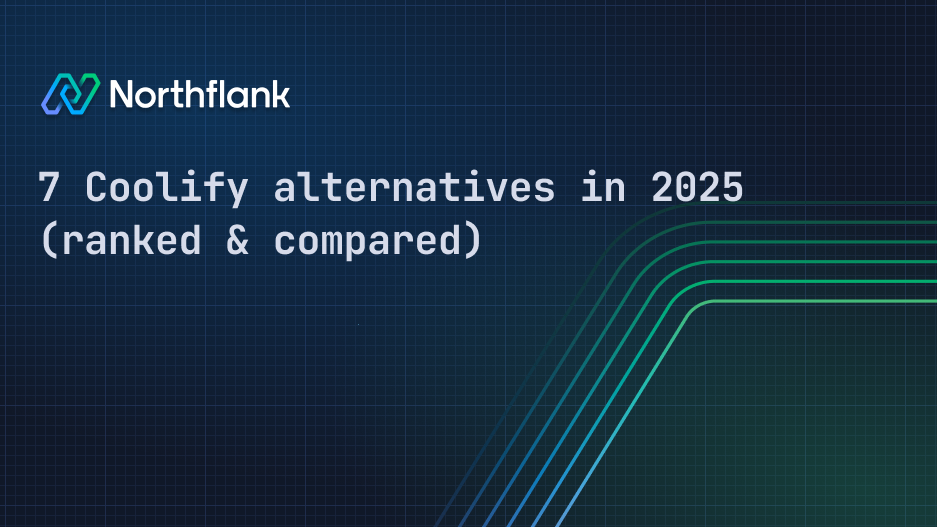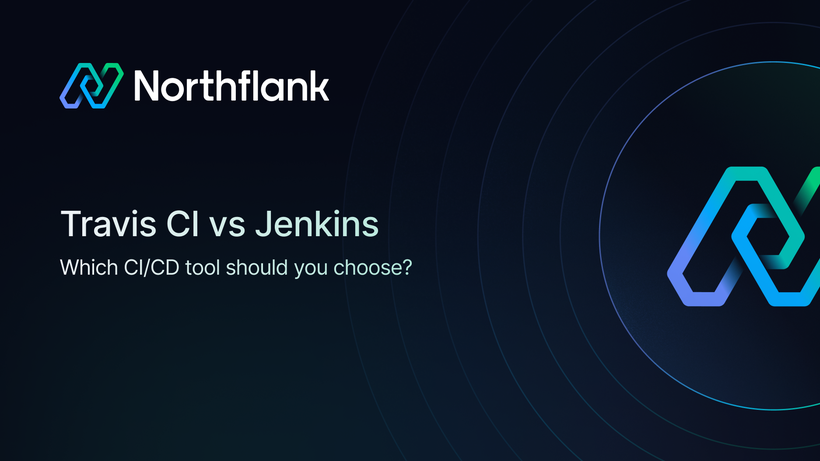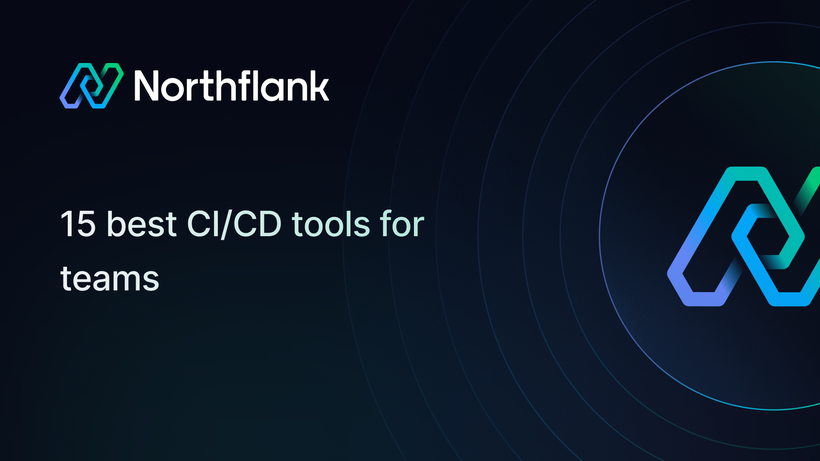

7 Coolify alternatives in 2025 (ranked & compared)
Coolify is an open-source platform that lets you deploy apps on your own infrastructure – essentially a DIY alternative to Heroku, Netlify, or Vercel.
It’s great for developers who want full control, but not every team can or wants to manage their own servers. Startups and enterprises often need more production-ready, fully managed solutions with robust CI/CD, scalability, and support. If you’re looking for powerful app deployment platforms like Coolify, but with hosted options or advanced features, then this guide is for you.
Below, we rank six of the best Coolify alternatives in 2025. We’ll cover what makes each platform unique, their ideal use cases, key features, pros and cons, and who should choose which.
Short on time? Here’s a quick breakdown of the best Coolify alternatives and what they’re known for:
- Northflank – Kubernetes-native self-service developer platform that gives you everything in one place: built-in CI/CD pipelines, container image builds, preview environments, and Kubernetes-native deployments.
- Heroku – Pioneering PaaS with simple git-push deployments and a rich add-on ecosystem, though costs rise at scale without a free tier
- CapRover – Self-hosted, open-source PaaS that brings Heroku-like simplicity to your own server or VPS; great for devs who want full control, but lacks built-in CI/CD or support
- Vercel – Frontend-focused cloud for Next.js and modern web frameworks, offering serverless functions and a global edge network (great DX, limited backend capabilities)
- Netlify – Jamstack deployment platform with Git-based CI/CD, built-in CDN, and serverless functions; ideal for static sites and frontend apps, but not built for complex backends
- Render – All-in-one cloud host for web apps, APIs, and databases, featuring auto-deploy from Git, background workers, and more affordable pricing than legacy PaaS
- Railway – Developer-friendly cloud with instant deployments and one-click databases; very easy for prototypes and MVPs, though usage-based free credits and fewer enterprise features limit long-term use

Northflank is a modern self-service developer platform that gives you everything in one place: built-in CI/CD pipelines, container image builds, preview environments, and Kubernetes-native deployments.
It provides a powerful abstraction layer over Kubernetes, so development teams get the benefits of containerized infrastructure without the usual complexity.
Northflank supports Bring Your Own Cloud (BYOC): you can run it fully hosted or deploy it into your own AWS, GCP, or Azure account for more control.
Ideal use cases: Deploying complex microservices or API backends, running full-stack SaaS applications in production, and any team that wants a cloud-agnostic platform.
Key features:
- End-to-end CI/CD automation
- Preview environments per branch
- Kubernetes under the hood
- Managed databases & add-ons
- Bring Your Own Cloud support
Pros:
- All-in-one platform: Combines continuous integration, continuous delivery, container orchestration, and monitoring in one service, so you don’t need to stitch together multiple tools.
- Cloud flexibility: Offers a fully managed cloud service or deployment into your own infrastructure.
- Microservices-ready and scalable: Built on a container/Kubernetes foundation, Northflank easily handles multi-service architectures, APIs, and background jobs. It’s designed for “Docker-first” projects and can scale to hundreds of services or even GPU workloads.
- Transparent pricing (with free tier): Northflank has a generous free tier (deploy 2 services, 2 jobs, 1 database addon) and straightforward usage-based pricing beyond that.
- Robust feature set: Includes features often only found in enterprise setups, like private network support (VPC peering), integrated secrets management, rollbacks, and fine-grained access control.
Cons:
- Learning curve for advanced features
- Smaller add-on ecosystem
- Not fully open-source
Who it’s best for: Development teams (from startups to mid-size enterprises) that want a production-grade, full-stack platform without managing Kubernetes themselves. If you’re building a SaaS product with multiple services or are practicing GitOps/CI/CD workflows, Northflank provides an ideal balance of power and ease-of-use.

Heroku is the original PaaS. It made deployment simple: push your code with Git, and it just worked. But it hasn’t kept up. As of late 2022, there’s no free tier, and scaling can get expensive fast.
Best for: Teams that need quick, reliable deploys and don’t mind paying more for simplicity.
Key features:
- Git-based deployments using buildpacks
- Wide selection of add-ons (Postgres, Redis, monitoring, etc.)
- Pipeline support for dev/staging/prod environments
- Review apps on pull requests
- CLI and dashboard for managing apps
Pros:
- Simple Git-based deploys
- Huge add-on marketplace
- Great for small teams and prototyping
Cons:
- No free tier anymore
- Expensive at scale
- Limited infra control and customizability
- Vendor lock-in risk
Read more: Top Heroku alternatives in 2025

CapRover is an open-source PaaS that runs on your own infrastructure. It’s popular with devs who want Heroku-like simplicity without giving up control. You deploy it to a VPS, install apps with one click (or Docker), and manage it via a slick GUI. But it’s entirely your responsibility to manage uptime, scaling, and updates.
Key features:
- Self-hosted PaaS you deploy on your own server or VPS
- One-click app deployments with built-in SSL and Docker support
- Built-in support for databases and custom webhooks
- Web GUI and CLI for managing services
- Supports custom domains and scaling with Traefik or NGINX
Pros:
- Free and open source
- Docker-native
- Easy to set up on any cloud VPS
Cons:
- Fully self-managed — you own infra, updates, security
- No built-in CI/CD or preview envs
- Not suitable for teams needing support or compliance

Vercel is the go-to for frontend teams, especially those using Next.js. It’s fast, sleek, and handles preview environments and edge deployments out of the box. But it’s not built for heavy backend logic.
Best for: Frontend-heavy apps, marketing sites, and teams who want best-in-class DX for modern web frameworks.
Key features:
- Native support for Next.js and modern frontend frameworks
- Automatic deployments from Git with preview URLs
- Serverless and Edge Function support
- Global CDN with smart caching
- Built-in analytics and performance monitoring
Pros:
- Sharp developer workflow
- Fast global CDN
- Native support for Next.js, Edge Functions
Cons:
- Backend support is limited
- Usage-based pricing can get expensive fast
- Free tier can’t be used commercially

Netlify is similar to Vercel but more static-site focused. It’s a solid choice for marketing sites and frontend apps, with nice extras like built-in forms and identity.
Best for: Jamstack apps, static sites, and content-heavy frontends.
Key features:
- Git-based CI/CD with deploy previews
- Global CDN for static content
- Built-in serverless functions
- Form handling and identity/auth tools
- Edge Functions and split testing support
Pros:
- Easy CI/CD pipeline
- Built-in forms, auth, edge functions
- Free tier allows commercial use
Cons:
- Not designed for backend apps
- Some features (e.g. identity, functions) cost extra at scale
- Less flexibility for dynamic workloads
Read more: Top Netlify alternatives in 2025

Render is a modern PaaS with a Heroku feel but better pricing and more features. It supports everything from web services to background workers and databases.
Best for: Full-stack teams looking for a balance between simplicity and backend power.
Key features:
- Auto-deploy from Git with zero-downtime deploys
- Managed databases (Postgres, Redis, etc.)
- Support for Docker and custom build environments
- Background workers and cron jobs
- Free HTTPS and global CDN for static sites
Pros:
- Supports Docker, workers, and cron jobs
- Predictable pricing
- Great for production apps
Cons:
- No self-hosted option
- Fewer integrations than Heroku
- Not as customizable as raw cloud infra
Read more: Top Render alternatives in 2025

Railway is designed for speed and simplicity. It’s great for MVPs, personal projects, and demos, but lacks depth for scaling.
Best for: Hackathons, indie hackers, and early-stage startups.
Key features:
- One-click app and database templates
- Automatic environment provisioning
- Unified project view (services + DBs)
- Auto-generated environment variables
- Usage-based pricing with $5 credit for new projects
Pros:
- Super easy onboarding
- Clean UI with built-in database support
- Free to start with pay-as-you-go pricing
Cons:
- Credit-based free tier (apps shut down when used up)
- Not great for complex apps or long-term prod use
- Limited enterprise or infra-level controls
| Platform | Best for | Key features | Self-hosted option | Free tier | Backend support | Pricing model |
|---|---|---|---|---|---|---|
| Northflank | Full-stack apps, microservices, BYOC | Full CI/CD, preview envs, Kubernetes, BYOC, GPU — most complete platform | ✅ Yes (BYOC) | ✅ Yes | Full support (persistent services, jobs, workers, databases, BYOC) | Usage-based |
| Heroku | Quick, reliable deploys for small teams | Git deploys, add-ons, pipelines, review apps | ❌ No | ❌ No | Good support (persistent web/worker dynos, but limited control/customization) | Dyno-based |
| CapRover | Self-managed Heroku-style deployments | Docker-native, one-click apps, custom domains, open source | ✅ Yes | ✅ Yes | Docker-native (manual infra, no CI/CD, self-managed only) | Free (self-hosted) |
| Vercel | Frontend-heavy apps using Next.js | Next.js support, edge CDN, serverless functions | ❌ No | ✅ Yes (non-commercial only) | Serverless-only (no support for persistent or long-running backends) | Usage-based |
| Netlify | Jamstack sites, static frontends | CI/CD, CDN, forms, auth, edge functions | ❌ No | ✅ Yes (commercial OK) | Serverless-only (limited backend flexibility, no persistent processes) | Usage-based |
| Render | Full-stack apps, APIs, background workers | Git auto-deploy, Docker, managed DBs, cron jobs | ❌ No | ✅ Yes | Full support (Docker, web services, workers, cron jobs, managed DBs) | Usage-based |
| Railway | MVPs, hackathons, small-scale apps | 1-click deploys, DB templates, usage-based pricing | ❌ No | ✅ Yes ($5 credit) | Basic support (easy web + DB deploys, no advanced infra or scaling options) | Credit + usage |
Choosing the right deployment platform depends on your project’s needs and your team’s priorities. Coolify itself offers a self-hosted solution for those who want full control, but the alternatives above provide options ranging from fully managed PaaS to hybrid models.
For front-end-centric projects, platforms like Vercel and Netlify excel at delivering speed and simplicity, though you may outgrow them as your product and team mature.
Heroku remains a solid choice for its ease-of-use and ecosystem, but be mindful of cost and the recent removal of free plans. Railway and Render represent the new wave of developer-friendly cloud platforms; Railway for getting started quickly on a small scale, and Render for balancing simplicity with more production features as you grow.
Among these, Northflank stands out as the #1 Coolify alternative for startups and enterprises in 2025. It gives you the convenient, all-in-one experience (CI, CD, hosting, databases) of a PaaS while embracing modern, cloud-native technology under the hood. With support for microservices, Kubernetes, and even deployment to your own cloud infrastructure, Northflank offers a level of power and flexibility that’s hard to match.


